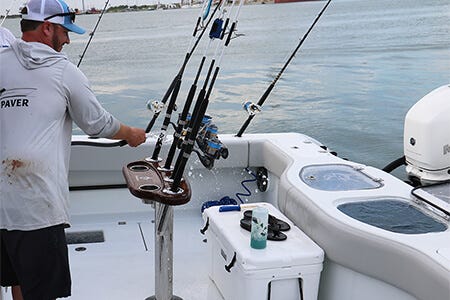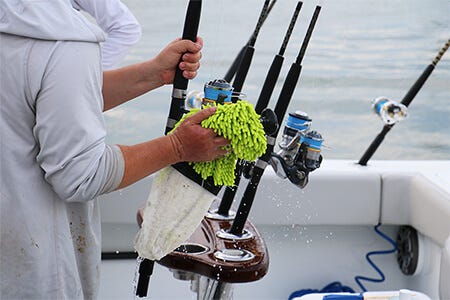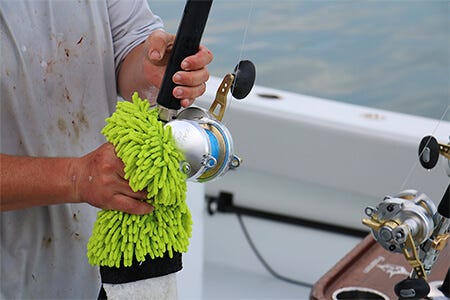How to Clean & Maintain Your Fishing Reels: A Real-World Guide
December 05, 2023 7 min read


I write this article with full knowledge that a Google search for “reel maintenance” or “how to clean a fishing reel” will return more entries than you can read in a lifetime. I know this because, as an avid saltwater fisherman who takes pride in his equipment, I’ve read a good portion of them throughout my own journey. These articles run the gamut from minimalistic “do-nothing” approaches to a level of OCD that would have you spending more time cleaning your reels than actually using them.
Contents
The Gap in Saltwater Reel Care
Compounding the issue are the volume of AI-generated articles that simply regurgitate what is already out there — right or wrong. My experience with the vast majority of these articles is that they make great sense, but fail the practicality test completely. In the real world, if saltwater corrosion is a fishermen’s first enemy, post-trip weariness is his second. Most of us don’t have hours — or energy — to spend deep cleaning reels and other equipment after every trip. A good saltwater reel cleaning maintenance routine has to be practical, minimalistic and effective.
The fact is, if you buy quality, mid-priced saltwater rods and reels, they are pretty darned tough.
Throughout my saltwater fishing journey, I’ve tried a lot of different approaches to reel cleaning and maintenance and have been around long enough to witness, firsthand, each of the outcomes. I’ve done the OCD thing, and I’ve taken the “zero-maintenance” approach very literally. Surprisingly, the outcomes were more similar than you might expect. The fact is, if you buy quality, mid-priced saltwater rods and reels, they are pretty darned tough. Knowing what to avoid, what to do daily, and what to do on a periodic basis will minimize your maintenance time and maximize the longevity — and looks — of your equipment.
Dunking Is Death
When it comes to things you simply have to avoid, any kind of reel submersion is at the top of the list. There is simply no maintenance routine that will effectively address the damage done by submersion in saltwater.
While most reels can withstand a fair amount of saltwater spray, a reel that is dunked will eventually allow water into the sensitive parts of the reel and require serious surgery and likely replacement. You can simplify your maintenance routine enormously by keeping your reels out of the bottom of your boat and away from situations that give water time to work past your reel’s defenses.
There is simply no maintenance routine that will effectively address the damage done from submersion in saltwater.
Daily Cleaning of Reels After Saltwater Use
If you avoid submerging your reels, your post-trip maintenance routine is pretty simple: Spray the reel with a light mist of fresh water and dry it off completely.
Every internet article will tell you to avoid using a hard stream from a hose, which will force water into the reel through any weak point.
You are better off not rinsing your reel at all than subjecting it to a hard spray.
I’ve tested this theory and it’s proven accurate. You are better off not rinsing your reel at all than subjecting it to a hard spray. Ideally, you just want enough water to dissolve and remove any salt residue, and even a damp towel can do the job.
If you are on the OCD side, you might consider spraying the body of the reel with a silicone spray, such as Blakemore Reel Magic. After eight years of hard use, my Shimano reels are showing some minor corrosion, and a periodic spray may have prevented this.
Periodic Reel Maintenance and Lubrication
A post-trip “mist and dry” routine by itself will keep your reels in good shape, but over time the oils and lubricants that protect your reel break down or are depleted, leaving the moving parts of your reel unprotected. Additionally, drag washers need to be maintained or replaced to ensure your drag operates smoothly when put to the test. Periodic maintenance routines will prolong the smoothness of your reel and ensure that it performs well when it counts. How often is “periodic?” A lot depends on how often you use your reels, but every three to four trips is a decent rule of thumb to do the following:
Periodic maintenance routines will prolong the smoothness of your reel and ensure that it performs well when it counts.
Oil exterior bearings and bushings:
The internal “guts” of your reel are generally well protected and do not require frequent maintenance, but any moving parts that are on — or near — the exterior of your reel need light oiling to lubricate them and protect them from corrosion. Make sure you use the proper oil, but in general a light machine oil will work well, especially if applied using a needle-tipped applicator. Here are the key areas to make sure you oil:
Roller Bearings: Highest on the “required lubricant” list is the roller bearing on the bail assembly. Line-born saltwater is constantly being driven into this bearing and, without frequent oiling, the line roller will begin “hissing” on a retrieve. If left long enough, the roller can seize up, causing line damage.
Reel Handle: Whether supported by bearings or bushings, the reel handle shaft is frequently exposed to saltwater. Keeping it properly oiled will not only keep the action smooth, it will keep saltwater from entering and corroding the shaft.
Drive Gear Bearings: These bearings are the outermost bearings in the reel body itself and are located where the handle screws in. Over time, water running down the reel handle can enter these bearings causing corrosion. A couple drops of light machine oil will keep these bearings in good shape and help repel water from getting further into the reel body.
Drag system maintenance:
Depending on the type of drag washers in your reel, periodic maintenance may be required. If your reel uses felt or cloth washers, they require frequent oiling and for the drag screw to be loosened when stored to avoid compressing the drag material. Most modern reels use ceramic or carbon washers, which simply need to be cleaned periodically to ensure there is no debris to cause them to stick.
To clean these, simply remove the spool, remove the retaining clip, and remove and wipe down each washer as well as the spool where the washers sit. Make sure you replace the washers in the same order you removed them as this will affect the drag performance. If your reel spool has a bearing, this is a good time to give it a drop of oil as well.
“Annual” Reel Maintenance
Okay, a disclaimer here. I don’t do this annually — not even close — so this is a “do as I say, not as I do” section. Should it be done? Yes. Annually? Well, your mileage may vary.
The geniuses on the internet all agree that annually you should take your reel completely apart and give it a thorough cleaning and regreasing. In my experience, I’ve done more harm than good to my reels by taking them apart, and for eight years, I haven’t done this for my Shimano spinning reels. They are still buttery smooth and the drag systems still sing like they should.
In my experience, I’ve done more harm than good to my reels by taking them apart.
I use the heck out of them every weekend and often several times during the week, and not to brag or anything, but I catch more than my share of drag-screaming fish. I do store them inside, and I do maintain them as outlined above. Eventually, they are going to need some internal care, but I’ll wait till they tell me they need it.
If I’m not feeling too cheap that day, I will probably send them off to Shimano and pay for them to fully service them. Depending on how handy you are, you may consider doing this yourself, but keep in mind that higher end reels can be fairly complex. However you do it, doing it “annually” unnecessarily may be inviting more problems than it prevents. If a reel gets dunked, it requires immediate surgery (and even then the long term prognosis isn’t great). Barring that, stay tuned in for the first sign of gear friction and deal with it when it presents itself.
Practical Reel Cleaning and Maintenance
When it comes to maintaining your reels in a saltwater environment, a practical, minimalistic approach that is diligently executed will yield better results than an “ideal” plan that is too impractical to actually follow.
Start by investing in mid-priced quality reels that are well sealed and use higher end materials in their components. The difference you pay up front will save you in both maintenance time and longevity.
Avoid submersion at all costs, as very few reels can withstand the dreaded dunking. Finally, keep your maintenance routine focused on the things that actually matter — mist, dry and the occasional oiling of external moving parts.
Wiping a reel down with a damp towel takes 30 seconds, but spend those 30 seconds per reel religiously after every trip. Once every few trips, have a machine oil bottle with a needle tip ready to go to hit those external bearings and bushings.
Keep your maintenance routine focused on the things that actually matter — mist, dry and the occasional oiling of external moving parts.
With quality reels, you don’t need to break your equipment down regularly to clean and regrease, but be alert for the first sign of friction and address it fully when it happens. Likely, by that time, those reels will be like old friends, and worth the expense of sending off for an expert pampering to get them ready for the next decade of adventures.













